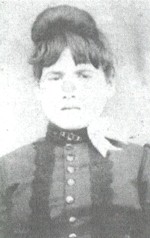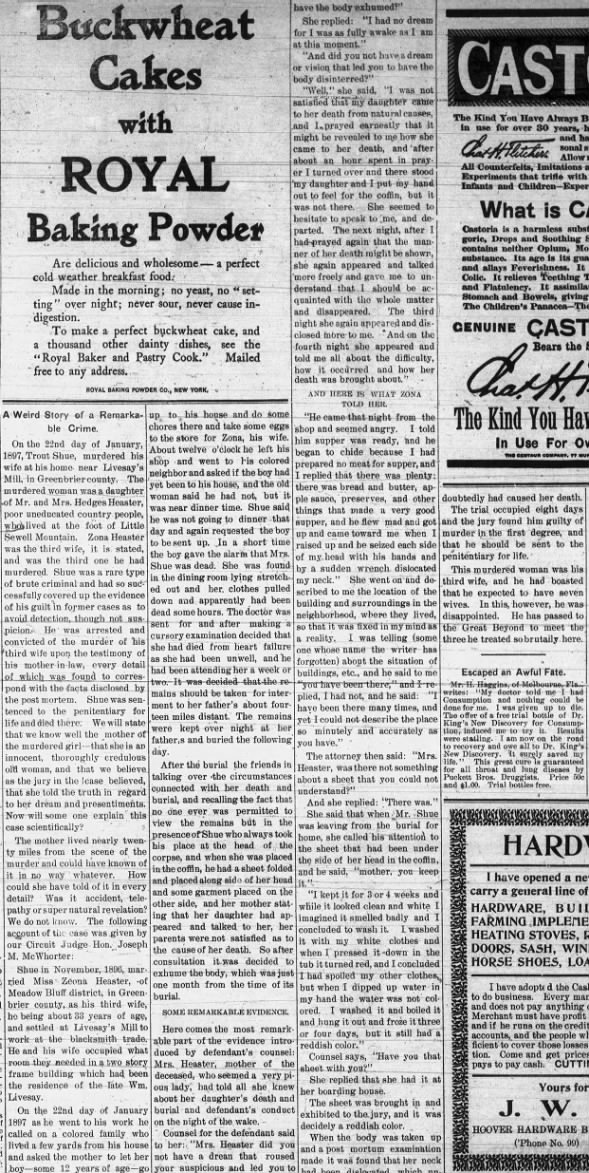
Was Elva Zona Heaster Shue murdered on January 22, 1897, or on January 23, 1897? It depends on which reference source you consult. Both The Encyclopedia of Ghosts and Spirits and RoadsideAmerica.com say her body was found on January 23, but I found an article from The Independent-Herald dated February 18, 1904 that reported her husband, Erasmus Trout Shue, murdered her on January 22. That’s something all sources agree on: that she was murdered. Another is that her ghost helped solve her murder, which is how she earned the moniker the Greenbrier Ghost.
Let’s take a look at this strange case that purports to be the only one in American history where a ghost aided in her killer being brought to justice.
The Victim

There isn’t a lot of information about the early life of Elva Zona Heaster, who went by Zona. What is known about her is that she was born in Greenbrier County circa 1873 and in 1895 she gave birth to a child out of wedlock.
Then, in 1896, she met Erasmus Stribbling Trout Shue, 33, the man who would become her husband…and her murderer. Trout Shue, as he was known (but is also sometimes referred to as Edward Shue), was a drifter who found work as a blacksmith. He married Zona shortly after meeting her.
Here’s where accounts once again differ slightly though. The Encyclopedia of Ghosts and Spirits lists their marriage date as October 26, 1896. Wikipedia also says the two married in October 1896. However, The Independent-Herald article cites Judge Joseph McWhorter, who said the couple married in November 1896. (He also called her “Zeona.”)
Either way, their honeymoon didn’t last long. A little more than a couple of months after tying the knot, Trout killed Zona. That’s probably the worst anniversary present any husband could give a wife.
Zona’s Death
On the day of her murder, Shue stopped by a black family’s house that lived nearby and asked the son, 12-year-old Anderson “Andy” Jones, to do some chores at the house that day and to take some eggs to the store for Zona.
At noon he stopped back by and asked if Andy had been to the house yet, which he hadn’t —and I’m thinking Shue knew that because all hell hadn’t broken loose yet. I wonder if the Jones family found this strange or not?
Also, it was near lunchtime, but Shue said he wasn’t going home that day for lunch. Again, likely because he knew there wouldn’t be any, as he’d killed his wife. Was that also out of character for him? Did the Joneses also find that strange?
Anyway, when poor Andy did finally go to the house, he found Zona and ran home to tell his mom.
A doctor was sent for, but his name isn’t mentioned in the newspaper article, just that he determined Mrs. Shue had died of heart failure.
The encyclopedia and Wikipedia both say that Dr. Knapp first listed her cause of death as “everlasting faint” but later changed it to “childbirth,” even though it’s not clear that she was pregnant. She could’ve been, but it would’ve been the first trimester. (Because keep in mind their whirlwind romance, and hasty, but short, marriage.)
The Husband’s Strange Behavior
Adding to Shue’s strange behavior, and something detectives these days would surely find suspicious, was that the husband had changed his wife’s clothing before the doctor arrived. Into a dress with a “high neck and stiff collar secured by a bow,” according to the encyclopedia.
He was also very attentive to her head. When the doctor came, Shue cradled her upper body in his arms while the doctor initially examined his wife, including the side of her head. However, when he went to examine the back of her neck, Shue sobbed in such “great distress” that the doctor abbreviated his examination out of respect for the man’s grief.
During her wake, friends and family noticed a couple of strange things. For one, friends found it odd that Shue never let anyone visit his wife’s body without him present. For another, the way she was situated in the coffin. Shue had her head almost propped up or cradled by a folded up sheet on one side and another garment of some sort on the other.
Why would that be necessary if she’d died of either heart failure or complications from pregnancy?
How Zona Became Known as the Greenbrier Ghost
Zona’s mother, Mrs. Heaster, was like many people in that part of West Virginia at that time: without much money but rich in faith. Likely in a quest for comfort and to reconcile her grief, she prayed for help in understanding her daughter’s sudden death.
Her prayers were answered when her daughter visited her from beyond the grave.
Both the encyclopedia and Wikipedia state that it was in her mother’s dreams that Zona paid her visits.
The newspaper article, however, quotes Mrs. Heaster as stating “I had no dream for I was as fully awake as I am at this moment.” (Also interesting to note is how her mother’s testimony even made it into the trial. Not from the prosecution, but from the defense! But we’ll get to all of that.)
Whether she was awake or dreaming, Zona detailed a life with an abusive husband who had killed her by breaking her neck.
Allegedly she demonstrated this by pulling a move straight out of The Exorcist —she pivoted her head around on her neck. Of course, this was decades before that movie would be released, so Mrs. Heaster had no frame of reference to make such a claim based on pop culture.
At trial, here’s what Mrs. Heaster told a jury that Zona had told her about her murder:
He came that night from the shop and seemed angry. I told him supper was ready, and he began to chide because I had prepared no meat for supper, and I replied that there was plenty: there was bread and butter, applesauce, preserves, and other things that made a very good supper, and he flew mad and got up and came toward me when I raised up and he seized each side of my head with his hands and by a sudden wrench dislocated my neck.
With the conviction that her daughter had met with foul play at the hands of her son-in-law, Mrs. Heaster took her accusations to the authorities and demanded justice.
The Exhumation
Likely, Zona’s body wasn’t exhumed just because Mrs. Heaster said her daughter’s ghost had told her that she was murdered. The husband’s strange behavior didn’t help, nor did it help that people were talking.
Against protest from Shue, a month after Zona’s body had been buried, it was exhumed and a post mortem examination performed. It was decided “her neck had been dislocated which undoubtedly had caused her death.”
Of course, the testimony Mrs. Heaster had given at trial could’ve been coached by the prosecution, knowing what they did after the post mortem exam. However, the fact remains that Mrs. Heaster was an upstanding, church-going, God-fearing member of the community who had just buried her daughter. She was grieving, sure, but she wasn’t prone to flights of fantasy. It was possible in her sorrow that she had somehow forged a connection with her daughter in the great beyond.
However, she did have some solid, albeit circumstantial, evidence in her possession too.
The Sheet
You know that sheet that was propping up Zona’s head in her coffin during the wake? Well, Mrs. Heaster asked her son-in-law about it and he said, “Mother, you keep it.”
However, it’s a little confusing because it must not have been buried with Zona. At some point, Shue must have removed it. Which seems strange because he was so concerned about her head, but maybe he did it because they didn’t want anything buried with her?
That’s the only thing to explain this account in the newspaper article: “…when Mr. Shue was leaving from the burial for house, she (Mrs. Heaster) called his attention to the sheet that had been under the side of her head in the coffin…”
Anyway, so Mrs. Heaster took the white sheet home, but after three or four weeks decided to wash it. Not because it looked dirty but because she “imagined it smelled badly.”
But when she washed it, the water turned red.
…when I pressed it down in the tub it turned red, and I concluded I had spoiled my other clothes, but when I dipped up water in my hand the water was not colored. I washed it and boiled it and hung it out and froze it three or four days, but it still had a reddish color.
The Arrest, Trial, and Conviction
Someone who wasn’t guilty of murdering his wife wouldn’t protest against an exhumation of her body. Nor would he predict he’d be arrested when her body was examined. He definitely wouldn’t say, “They cannot prove I did it,” even before said examination took place or any accusations about her cause of death were made.
But Trout Shue did all of those things. And as he predicted, following the post mortem exam, he was arrested and charged with murder, to which he plead not guilty.
As it turned out, Shue was an unsavory character. He’d previously been in jail for stealing a horse, and his second wife died under mysterious circumstances. His first one got off lucky. He abused her, but she was able to escape the fate of death by divorcing him. Zona was his third wife in what appeared to be his goal to be married seven times.
However, his mother-in-law, with Zona’s help, squashed those ambitions.
Interestingly, Mrs. Heaster’s story about her daughter’s ghostly revelations was considered hearsay in the court’s eyes and therefore was not admissible as evidence. However, the defense introduced it to the jury during their cross-examination of Zona’s mom. Probably in an effort to make her seem crazy.
They’re also the reason the stained sheet became an exhibit during the trial, which lasted eight days and resulted in the jury finding Shue guilty of murdering his wife. They sentenced him to life, which ended up being pretty short. He died at the West Virginia Penitentiary in Moundsville.
Accounts differ as to exactly when he died though. The encyclopedia lists his death as March 13, 1900. A newspaper article from the Beckley Post-Herald dated March 5, 1953, reported he died eight years after his sentencing.
The Greenbrier Ghost’s Marker
On US 60 (eastbound) at junction with I-64 just outside Sam Black Church in West Virginia, a historical marker titled “Greenbrier Ghost” commemorates the case with the following inscription:
Interred in nearby cemetery is Zona Heaster Shue. Her death in 1897 was presumed natural until her spirit appeared to her mother to describe how she was killed by her husband Edward. Autopsy on the exhumed body verified the apparition’s account. Edward, found guilty of murder, was sentenced to the state prison. Only known case in which testimony from ghost helped convict a murderer.
The Independent-Herald Article
Here’s the earliest newspaper article I could find about Zona Heaster Shue’s murder and the case of the Greenbrier Ghost.
Check-In
Have you ever been to West Virginia?
Suggested Reading
Interested in reading more about this case? Check out: The Man Who Wanted Seven Wives: The Greenbrier Ghost and the Famous Murder Mystery of 1897 by Katie Letcher Lyle.
Please note: We participate in the Amazon Affiliate Program. If you purchase anything after clicking some of the link(s) or image(s) in this post, we may earn a small commission. (For which the Skeleton Crew says, “Thank you!” That helps cover our website maintenance and hosting fees!) For more info, see our affiliate policy.
Sources
The Encyclopedia of Ghosts and Spirits
“A Weird Story of a Remarkable Crime,” The Independent-Herald, Feb 18, 1904
Courtney Mroch is a globe-trotting restless spirit who’s both possessed by wanderlust and the spirit of adventure, and obsessed with true crime, horror, the paranormal, and weird days. Perhaps it has something to do with her genes? She is related to occult royalty, after all. Marie Laveau, the famous Voodoo practitioner of New Orleans, is one of her ancestors. (Yes, really! As explained here.) That could also explain her infatuation with skeletons.
Speaking of mystical, to learn how Courtney channeled her battle with cancer to conjure up this site, check out HJ’s Origin Story.



I totally believe Mrs. Heaster that her daughter’s ghost visited her. Like you said, this was before The Exorcist movie, so Mrs. Heaster wouldn’t imagine something like that having to do with heart failure or childbirth even if Mrs. Heaster considered her son-in-law to be evil. What a tragic case! I’m so glad Shue was caught and stopped at 3 wives.